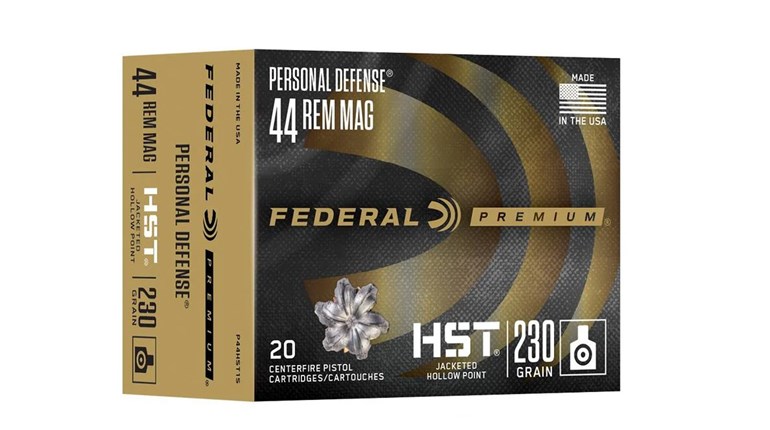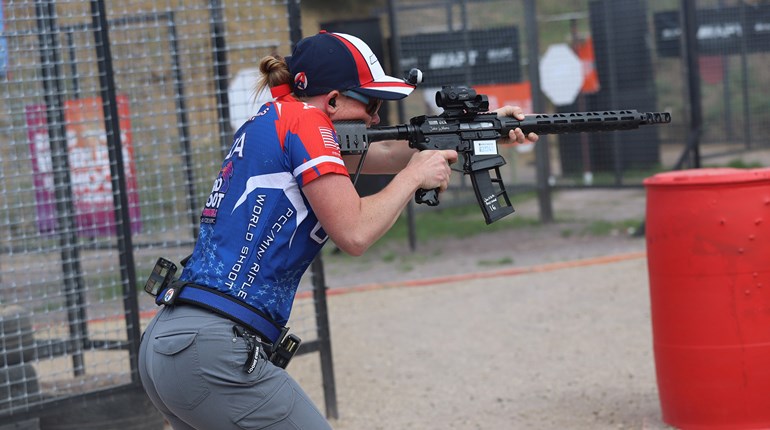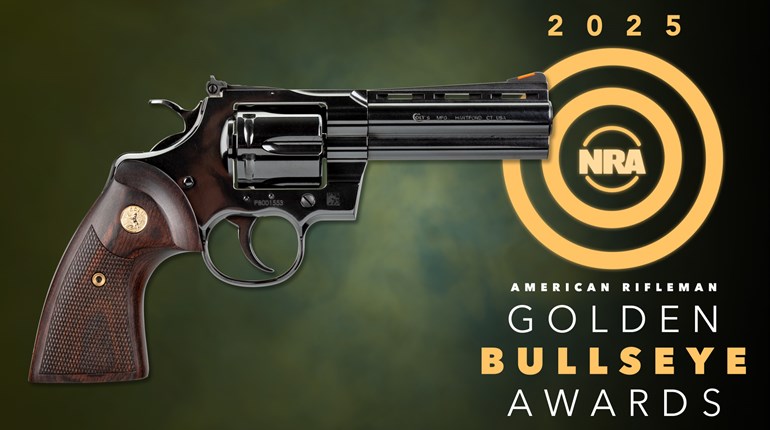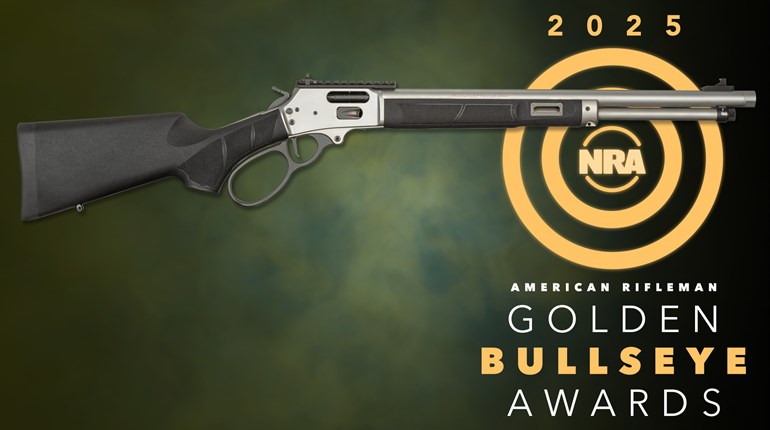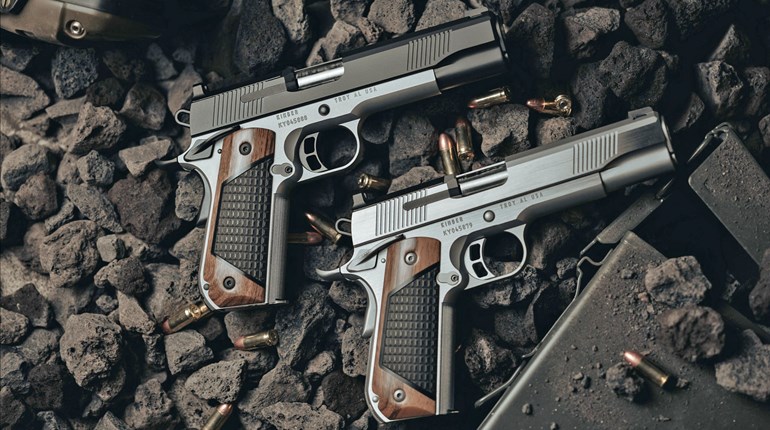
The new Colt Anaconda has been briefly summarized as a .44 Mag. built on an oversize Python frame and action. I’m thinking someone should have added the word “dramatically” to that description. Admittedly, it’s been a while since I’ve seen or handled a new Python, but I was almost overwhelmed upon first seeing the new Anaconda up close. This was not due to a lack of similarity between the Anaconda and Python; externally they look very much alike. It’s the Anaconda’s increased size, particularly in cylinder diameter that made me catch my breath. Its 1.75-inch diameter seemed to dwarf the Python’s 1.55. But let’s start with the basics.
The new Anaconda is a large-frame, stainless steel, .44 Mag. revolver that can be fired either single or double action. Like its smaller brother, it proudly wears the ventilated rib that was perhaps the most distinguishing feature of the original Python revolvers. The rib is an integral part of the barrel rather than a separately manufactured piece attached to the barrel at some point in the assembly process. That’s both the right way and the most expensive way to do it. The Anaconda incorporates a full-length ejector-rod shroud that prevents the ejector rod from being bent out of line from an accidental external blow. In addition, the shroud adds weight up front near the muzzle, which helps absorb felt recoil and expedites recovery between shots. In today’s world where the dominant role of the handgun is self-defense rather than hunting or recreational shooting, these capabilities are considerably more important than ever. Every exposed edge on both the shroud and the rib was smooth, thus ensuring the front end of the gun is snag-free.

A slightly recessed crown prevents damage to the rifling in case of any accidental bumps against the muzzle. The stainless steel frame and barrel are highly polished on all external surfaces, with the exception of the upper surface of the ventilated rib and topstrap, which appear to be slightly bead blasted to reduce glare. This polished finish includes the hammer and trigger, which were not polished on the original Anacondas. The topstrap is drilled and tapped for a scope, and while that may not seem to be of interest to anyone in a tactical application, given today’s increased use of various “dot” optics on defensive handguns, it could prove useful. Front and rear sights are blued, with the front blade having an orange insert for increased visibility. If that doesn’t meet with your approval, it can easily be removed by removing one screw and inserting a different blade. The adjustable rear-sight blade lacks the white outline of the original Anaconda that I borrowed from a nephew, but the vertical blade is dovetail mounted into the sight base as opposed to the less expensive technique of “sandwiching” the blade between two chunks of metal. In my opinion this makes for a much cleaner, less busy sight picture, because the rear surface of the blade is uncluttered with other pieces of metal. There is a small lock screw in the rear sight that secures the blade in place. When adjusting the sight for windage, the lock screw must be loosened before turning the adjustment screw and then re-tightened to secure the blade in place when finished. Good idea for a gun with the recoil of a .44 Mag.
The grips on the new Anaconda are different than those on either the new Pythons or the original Anacondas. They are the Hogue rubber grips that slide on from the base of the frame and are secured by a screw in the bottom. They don’t enclose the Anaconda’s backstrap, resulting in reduced distance from the back of the gun to the trigger; a real boon for shooters with small hands trying to run a powerful double-action revolver. Surfaces on the grips evidence the fine, raised bumps of Hogue rather than impressed-checkering style of the Pachmayr brand on the older guns. Likewise, the finger groves are more pronounced and slightly narrower and longer. These grips made the big Anaconda much easier for me to control, whether firing single or double action.

The Colt Anaconda has a 1:20-inch LH twist, whereas Colt’s competitors use right-hand rifling twists in their .44 Mags. Using various brands of ammo loaded with different weight bullets in a variety of big-bore revolvers, I can’t feel any difference that might be attributable to twist rate direction. Basically, faster twist rates will allow you to stabilize heavier bullets in a given caliber. In a defensive application against a human predator, I don’t see much to be gained by using a heavier bullet (other than felt recoil), although I did include a heavy-for-caliber Garrett Cartridge load in testing. Practically speaking, accuracy with all three brands of ammo tested was the same.
There are some potential advantages to be had from the impressively large cylinder mentioned earlier. While the cylinder chamber walls of the Anaconda are only slightly larger, the cylinder’s length is .2-inch longer than my old Smith & Wesson Model 29, which means an extra .2 inch in overall cartridge length for those longer, heavier bullets that could be useful in bear country. That extra .2 inch of steel in the cylinder also adds weight to help tame the recoil of whatever loads you care to shoot. This Colt 6-inch-barreled Anaconda offers 3 more ounces of weight compared with the Smith & Wesson Model 629 that’s equipped with a 6.5-inch barrel and full-length underlug (53 ounces vs. 50 ounces.) And for the record, the Anaconda’s larger cylinder still accepts the same HKS speedloaders used by the N-frame Smith & Wessons.

The most exciting feature in the new Anaconda is the trigger system. Colt abandoned the old coil-spring system in the original Anaconda and has gone to the same type V-spring design used in the new Pythons. Starting with the numbers, my Lyman trigger gauge measured slightly more than 9 pounds for double action and 6 pounds to fire single action. However, when you examine the geometry of the Anaconda’s trigger and the ergonomics of a human hand pulling it, you’ll see some anomalies. The bottom of the trigger curves dramatically forward inside the trigger guard; when it’s at rest, the tip of the trigger is nearly half an inch in front of the upper end of the trigger. In order to pull the trigger double action using the trigger gauge, the thin tip of the gauge must be placed high on the trigger about a half-inch away from the tip of the trigger, meaning you’ve lost about 2⁄3 inch of the length of your lever. When firing double action using your hand, your trigger finger makes contact with the trigger/lever closer to the tip of the trigger. You’ve basically lengthened your lever, meaning it actually doesn’t take 9 pounds of force to do the same amount of work (pull the trigger).
The geometry is different when firing single action. Because the trigger has moved to the rear of the trigger guard, the gauge’s contact point with the trigger is now closer to the tip, but still not as close to the tip as when firing with your hand. In short, the gauge readings are higher than your trigger finger “readings.” Just for comparison, trigger gauge readings on the original Anaconda were 12 pounds double action versus. 3.5 pounds single action.
Perhaps the observations of a serious gun guy would be more meaningful than mere numbers. I had an opportunity to take the Anaconda to Gunsite Academy and spend some trigger time with Lew Gosnell. He has been the Range Master at a number of Gunsite events I’ve attended and knows a thing or two about revolvers. Initial shooting was on steel to get the feel of the gun. I made a comment to the effect that the trigger seemed to stack a bit, to which Gosnell replied, “Yes, but it’s a ‘stackable stack’.” Since he occasionally throws bits of Zen-like wisdom my way, I stopped to think about that. When I substituted the word “manageable” for “stackable,” I knew what he meant.
 All guns have trigger stack, because you’re starting with zero applied pressure and increasing it until the trigger moves. The issue is how far the trigger has to move to fire the gun and do you have to noticeably adjust your pressure somewhere during its travel. A good 1911 trigger typically requires between 3 to 5 pounds of applied pressure and only has to move a fraction of an inch to drop the hammer. A double-action revolver trigger has to move something like half an inch to cycle the action, push the transfer bar up until it covers the firing pin and then release the hammer. The new Anaconda trigger moves very smoothly with a steady, consistent pressure buildup until the gun is almost ready to fire. An educated trigger finger can feel the slight increase of pressure required just before firing, which allows the shooter to hesitate briefly to verify sight picture. The process is called “staging,” and is easy to do with the Anaconda, unlike most factory revolvers I’ve shot.
All guns have trigger stack, because you’re starting with zero applied pressure and increasing it until the trigger moves. The issue is how far the trigger has to move to fire the gun and do you have to noticeably adjust your pressure somewhere during its travel. A good 1911 trigger typically requires between 3 to 5 pounds of applied pressure and only has to move a fraction of an inch to drop the hammer. A double-action revolver trigger has to move something like half an inch to cycle the action, push the transfer bar up until it covers the firing pin and then release the hammer. The new Anaconda trigger moves very smoothly with a steady, consistent pressure buildup until the gun is almost ready to fire. An educated trigger finger can feel the slight increase of pressure required just before firing, which allows the shooter to hesitate briefly to verify sight picture. The process is called “staging,” and is easy to do with the Anaconda, unlike most factory revolvers I’ve shot.
I had a very brief concern when I noticed that the cylinder could be wiggled slightly when the hammer was at full cock for single-action firing. Then I remembered that the older V-spring Colt revolvers exhibited this same behavior, but the cylinder would lock tightly in place when the trigger was pulled all the way and the hammer fell. Same with the new Anaconda; the cylinder is “bank vault” tight at the time of cartridge ignition, regardless of whether you fired single or double action.
Despite “Dirty Harry’s” successful career carrying a large-frame .44 Mag. in a shoulder holster under a sport coat, I’d have some reservations about trying to carry the new Anaconda concealed in my daily life. First of all, “Dirty Harry” was fiction. Nobody wears a large-frame, all-steel revolver under a sport coat 10-12 hours a day unless they’re planning on buying a truss to go with it. Also, the character was a cop, and there was no threat of him losing his carry privileges if the gun occasionally showed itself. California can revoke a regular citizen’s CCW permit for an unintended “flashing.”
Home defense is an entirely different matter as you’ll likely be holding the gun rather than having it holstered. For home defense or urban personal protection, I’d opt for .44 Spl. loads. There are some excellent ones for self-defense that are fine options if you’re concerned about possible over-penetration or felt recoil.
If you’re traveling and you need to defend your “temporary castle” on the road, the Anaconda’s ability to handle full-house .44 Mag. loads could prove a real blessing. I’m not sure if there really are demented cannibals roaming the countryside in armored vehicles, but I have camped in country where bears are known to occasion, and my handgun of choice has almost always been chambered in .44 Mag. I’d be very comfortable with a new Colt Anaconda at hand.












